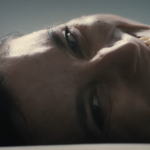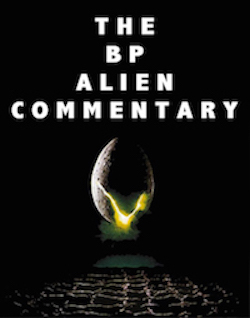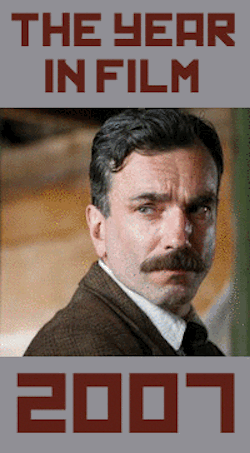Home Video Hovel: The Max Linder Collection, by Scott Nye
You may not know his name, but if you have any experience with pre-1940s (especially silent) comedy, you have seen his influence at work. He did the “human mirror” gag (in which one person tries to fool another into thinking they’re looking at a reflection by mimicking their movements) decades before the Marx Brothers or Looney Tunes made it a staple. He was close friends with Charlie Chaplin, often staying up ‘til dawn refining gags with him; Chaplin would later send him a signed photo, addressed, “To Max, the Professor, from his disciple, Charlie Chaplin.” Hell, if you picked up Criterion’s tremendous Pierre Etaix box set, you’ve seen a tribute to him in that filmmaker’s Yo Yo. And even just within these four films, produced during a rather rough period in his life and career, while he was making films in America, the appeal and talent of Max Linder is enormously evident, with at least one film more anarchically confident than just about anything I’ve seen of the period.
First up, chronologically speaking, is the thirty-minute short feature, Max Wants a Divorce, from 1917. In it, Max (he nearly always played “himself”) receives a letter stating he stands to inherit three million dollars from his just-deceased uncle, under the provision that he is a bachelor. Unfortunately, the letter has come to him on his wedding night, with his wife beside him. Their responses diverge in the manner one might expect for the early 20th century, wherein men assumed responsibility for the money and women for maintaining a home, but Max soon convinces his wife that, hey, three million dollars. The only trouble is the divorces didn’t come quite so easily in those days, and their presumably airtight plan to have her catch him in a manufactured act of infidelity hits innumerable obstacles, from simply picking the woman in question (he has his eye on a young slender woman, she feels an older lady of large carriage would do just as well) to, well, mixing up one’s rented apartment with a radical psychiatrist. Screwball comedy knows no limits, and this half-hour delight gets them there quite quickly.
Expanding into a feature format, the hourlong Seven Years Bad Luck gets off to something of a slow start, though, given that the first fifteen minutes relies extensively on the aforementioned “human mirror” gag, which doubtlessly would have brought the house down in 1921, I feel safe in assuming my reaction is a casualty of time, rather than the talent of all involved. By the time Max realizes his mirror is broken, and his luck may be doomed, the film really kicks into high gear, as he tries to avoid various fates, only to be done in all the worse by them. A surprisingly long section of the film finds him simply trying to travel on a train without paying the fare, the results of which become almost Breaking Bad-esque in the extent to which they are unforeseen and which pull him deeper into crime and deceit. But, you know, for laughs (and it is deeply, deeply funny).
Be My Wife, from that same year, has no trouble racing right along – within the first seven minutes, there’s a comedic stunt involving an animal so flawlessly executed I can’t even begin to conceive the odds of it actually working. Plus plenty of fun leading up to it. This time, Max is trying to marry his love, but her nosy aunt thinks the boy trouble, preferring instead the rather dull Simon, whom Max would have no trouble dispatching if not for his rascally dog. So he concocts a series of ever-more-elaborate schemes to spend time with her. But things only get more complicated once their romance is consummated, all of which results in Max hiding out in a boiler room trying to catch his wife making love to another man, neither of whom will ever show. It’s all quite mad and spectacular.
But it’s not nearly as much of either as the most unusual film in the set – The Three Must-Get-Theres, from 1922. As those who pronounce the film out loud might have guessed, it’s a spoof on The Three Musketeers, but only in the way Ducks Dodgers in the 24½th Century is really at all a parody of Buck Rogers. It’s more like a loose idea and setting on which Linder can riff endlessly, and riff he does, continuously confounding our notions of perspective, time, place (a telephone hung on a tree is a particular delight), and even basic facts of nature. When Dart-in-Again (Linder) leaves his farm home in hopes of becoming a dashing hero, he doesn’t get the tearful goodbye with his sweetheart – his donkey does, with the farm’s cow. Later, Linder has a sword fight with his wildly-kicking mule, in full frame no less! No trickery involved, just a man convincingly going toe-to-toe with an animal that could very well accidentally kill him. This is the film I alluded to at the top, one with immense spirit and bravado. Too often, comedy comes from reducing our protagonist. Linder actually draws humor from building him up – the more accomplished and talented he is, the funnier the film becomes. The closer comparison is not so much Daffy Duck, then, as Bugs Bunny.
No special features are provided, but with three-and-a-half hours of comedy (three hourlong features, one half-hour short) at one pretty low price, it’s a bargain. The films have been recently restored by the great Lobster Films, and while the results aren’t exactly breathtaking, they films look good for their age. Kino has an unfortunate habit of inserting digital, newly-produced intertitles (some of us like the originals!), but they’re not too distracting, and the format gets varied enough to keep them eye-catching. Each film gets its own newly produced score, by Maud Nelissen (The Three Must-Get-Theres), Eric Le Guen (Be My Wife), Robert Israel (Seven Years Bad Luck), and Donald Sosin (Max Wants a Divorce), each of which nicely complements its respective film.





























